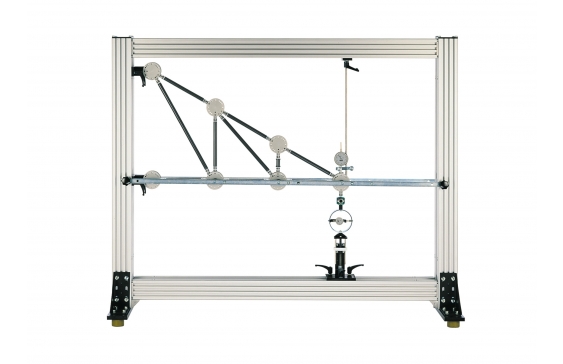SE 110.44 Deformation of trusses

When a component is placed under load it undergoes elastic deformation. This deformation can be calculated by determining elastic lines for example. Elastic lines describe the deformation of the complete component in the form of a mathematical equation. In reality, it is often only the deformation at specific points on the component which is of interest. Energy methods can be applied to determine these deformations more simply. Castigliano’s first theorem uses energy methods to calculate the deformation of a point on the component. The theorem is applicable to both statically determinate and indeterminate systems.
In SE 110.44 the deformation of a single plane truss at one point is determined using Castigliano’s first theorem. The truss under investigation is made of bars joined together by a articulated construction using node disks.
The trusses can be considered as ideal trusses. The bars have special snap-lock fixtures on their ends allowing them to be fixed easily into the node disks. A load application device attached to a node disk generates an external force.
The range of different bar lengths provided permits three forms of truss to be constructed. The bars are made of PVC, so their deformations are clearly visible.
All the component elements of the experiment are clearly laid-out and housed securely in a storage system. The complete experimental setup is arranged in the frame SE 112.
- elastic deformation in a single plane truss
- construction of various truss
- application of Castigliano’s first theorem
Truss with 19 PVC bars
- height of truss: max. 450mm
- length of truss: max. 900mm
- bar lengths: 2x 150mm, 5x 259mm, 7x 300mm, 1x 397mm, 3x 424mm, 1x 520mm
- angle between bars: 30°, 45°, 60°, 90°
- maximum bar force: 200N
Load application device
- measuring range: ±500N
- graduation: 10N
Dial gauge
- measuring range: 0…0,10mm
- graduation: 0,01mm
- investigation of the deformation of statically determinate trusses
- construction of different truss forms possible
- 2 supports with node disks
- load application device with force gauge mountable on different node disks
- dial gauge to record the deformation of the truss under load
- cross arm for lateral stability of truss
- storage system to house the components
- experimental setup in frame SE 112
- elastic deformation of truss under point load
- calculation of support reaction and bar forces
- principle of work and strain energy
- application of Castigliano’s first theorem to calculate the deformation at a defined point
- verification of the calculated deformation possible by the principle of virtual work
- comparison of the deformations of different trusses under the same load
- comparison of measured and calculated deformation
